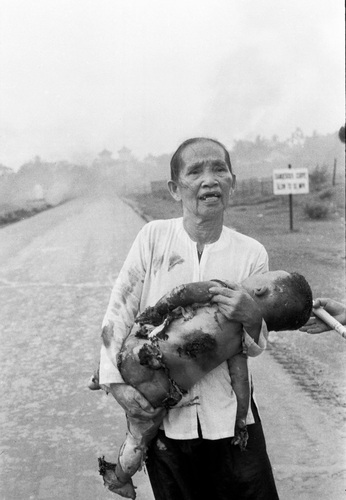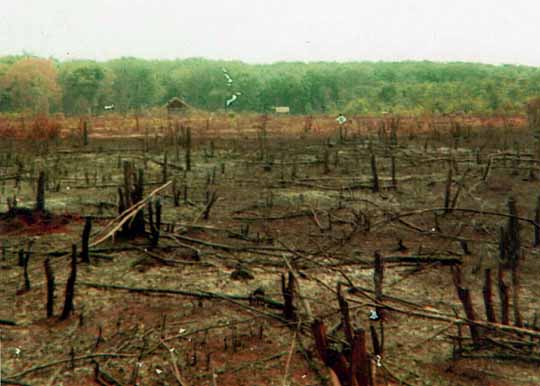by Anna Sykes
 |
| A Vietnamese victim of US chemical weapons |
Historians tend to focus their attention on the atrocities
and effects of prominent tragedies such as the Holocaust, massacres or slavery.
However, many fail to acknowledge the significance of the effects of the
Vietnam War on ordinary civilians.
The Vietnam War lasted for 20 years
(1955-1975) and resulted in the death of 2 million people, leaving around 3
million wounded, many of whom were civilians. During the war, the U.S forces
used a total of around 20 million gallons of herbicides from 1962 to 1971, most
of which was focused in the dense jungle vegetation surrounding the boarder
with Laos and Cambodia. The mass use of chemical warfare was primarily in order
to cut down the jungle foliage, thus enabling air forces to spot Vietcong
troops more easily.
This was not an ordinary war. The Vietcong (National
Liberation Front) used tactics of attrition and fought a guerrilla war using
techniques such as ambushing, planting landmines and “hanging onto the belts”
of the Americans- all of which appeared alien to the American troops. These
methods far from resembled the familiar warfare which had been used during the
First and Second World War.
Many say that the tactics which were used by the guerrilla
forces in Vietnam represented the ‘classic’ three-phase Maoist model, a Theory
of People’s War that divides warfare into three stages. The first phase
consists of guerrillas earning the support of the population through various propaganda
techniques, gaining the “hearts and minds” of the people and attacking the
centre of government. This is followed by the second phase, in which attacks
are directed towards the government’s military forces and institutions. In
Phase Three, conventional fighting is used to seize and take over cities,
overthrowing the government in order to establish control of the nation.
Guerrilla warfare was successfully waged in Vietnam, a form of fighting which
was along the lines of Mao Zedong’s Ten Principles of War. In response to this,
the American troops resorted to the use of defoliants, such as Napalm and ‘Agent
Orange’ (a combination of the code names for Herbicide Orange and Agent LNX). These
were used to focus on destroying crops and by 1969 around 1,034,300
hectares of forest had been destroyed. However, this major herbicide also had
huge social and ecological impacts, affecting the lives of many soldiers (both
American and Vietnamese) and ordinary citizens. The overall herbicidal warfare
programme which lasted till 1971 was named ‘Operation Ranch Hand’, in which the
U.S Air Force flying C-123s, fitted with developed spray tanks able to hold up
to 1,000 gallons of herbicides (50 times the concentration than for normal
agricultural use), sprayed 5 million acres of forest.
 |
| Result of eco-destruction on the Vietnam jungle |
It has been recorded that US forces sprayed more than
110,00 tons of toxic chemicals between 1961 and 1971, causing the Vietnam was
to be the biggest chemical warfare and the first war of eco-destruction in
world history. A crucial factor in the destruction and harm caused by such
warfare was due to the chemical components of the liquids used. Agent Orange
consisted of dioxin, one the most toxic elements ever produced and in Agent
Blue there was arsenic long-time poison.
Furthermore, Dioxin and hexachlorobenzen
are known to be persistent organic pollutants. An article posted in early 2014
exposed the horrors of chemicals, such as those aforementioned, on Vietnamese children
in orphanages fifty years on from the disaster. The effects ranged from
physical disabilities, including missing or under-developed limbs and
extremely curved spines, to various mental disorders. The photographer
Matt Lee Anderson was quoted saying: 'Americans are the ones responsible, but we
aren't giving any aid to the country at all. I felt horrible photographing
these poor children.' The lack of support for these casualties from the
American Government is down to the fact that there isn’t solid enough evidence
to link such health problems to America’s use of these chemical weapons. CNN
reported figures from the Vietnam Red Cross, which showed that Agent Orange has
affected around one million Vietnamese people and led to some 150,000 children
suffering from birth defects. These diseases range from cancer and reproductive
abnormalities, to type 2 diabetes.
Agent Orange wasn’t the only chemical weapon that
produced horrendous results, U.S. troops also used a substance known as
napalm from 1965-1972. Napalm is a jelly-like substance, formed of a mixture of
plastic polystyrene, hydrocarbon benzene, and gasoline. When such a substance
is ignited, it sticks to the skin and burns for up to ten minutes, resulting in
an unbearable pain and normally causing death. This effect occurs due to the fact
that napalm partially combusts oxygen in air, turning carbon dioxide into the
poisonous substance, carbon monoxide. Kim Phúc’s village was napalmed by
American forces when she was only nine years old. Kim is one of the rarest
survivors of a napalm attack stating that “Napalm is the most terrible pain you
can ever imagine”, she then went on to explain that“ water boils at 212°F.
Napalm generates temperatures 1,500°F to 2,200°F.” Thus although unlike Agent
Orange, the effects of such weapons are not persisting, 60% of those who were
victims of napalm attacks suffered fifth degree burns, meaning that the burn corroded
the skin and went down to the bone.
So we are thus lead to question why such effects and
questioning surrounding the war and the warfare used are so commonly
disregarded.
Firstly, on a simple level this could be attributed to the fact
that American ‘lost’ the war. It was a personal failure on a national scale. Fifty-eight
thousand were killed, two thousand captured, and three hundred fifty thousand
maimed and wounded; the effects of the war can be seen on a global scale. The
consequences are not simply limited to physical effects but they also encompass
a gamut of psychological trauma. In particular, there were large number of cases
regarding the effects of Post Traumatic Stress Disorder. So, the war was
ignored and forgotten as it was a failure for the Government and an
embarrassment for the people; the Americans simply didn’t understand the war in
which they were fighting.
The veterans returned home, having been portrayed by
the media to the public as crazed psychopathic killers who lacked morals or
control over their aggression. This is clearly captured in the example of the
My Lai Massacre, where American troops were said to have killed between 347 and
504 unarmed civilians in South Vietnam on March 16, 1978. This made it hard for
soldiers returning to transition and fit comfortably back into society. Many
also point to the lack of care and assistance for the soldiers who had
experienced such harrowing traumas. Thus, for many US citizens the war is over
and long forgotten.
Comments
Post a Comment
Comments with names are more likely to be published.